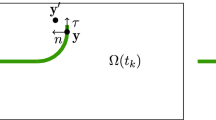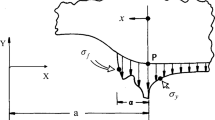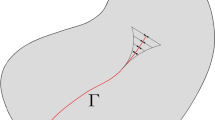Abstract
A finite element technique for determination of elastic crack tip stress intensity factors is presented. The method, based on the energy release rate, requires no special crack tip elements. Further, the solution for only a single crack length is required, and the crack is “advanced” by moving nodal points rather than by removing nodal tractions at the crack tip and performing a second analysis. The promising straightforward extension of the method to general three-dimensional crack configurations is presented and contrasted with the practical impossibility of conventional energy methods.
Résumé Une technique d'analyse par éléments finis est présentée pour la détermination des facteurs d'intensité des contraintes élastiques à la pointe d'une fissure. Basée sur le taux de relaxation d'énergie la méthode ne nécessite pas d'éléments de forme particulière à la pointe de la fissure. En outre, seule est requise la solution pour une longueur déterminée de fissure simple: le processus d'extension de la fissure est obtenu en déplaçant les points nodaux du réseau plutôt qu'en ôtant les composantes de traction nodale à la pointe de la fissure et en procédant à une seconde analyse.
On présente les possibilités prometteuses d'extension de la méthode à des configurations tridimensionnelles plus générales de fissures, en contraste avec les impossibilités auxquelles se heurtent les méthodes conventionnelles basées sur des considérations énergétiques.
Zusammenfassung
Das Verfahren der endlichen Elementen wird angewandt zur Bestimmung der elastischen Spannungsintensitäts-faktoren an einer Rißspitze. Begründet auf die Geschwindigkeit der Energiefreilassung braucht dieses Verfahren keine spezielle Rißspitzenangaben. Weiterhin braucht man nur die Lösung für eine einzige Rißlänge, und der Rill wird fortbewegt eher durch Versetzung von Knotenpunkten als durch Entziehung von Knotenzugspannung an der Rißspitze und durch Ausführung einer zweiten Analyse. Die vielversprechende direkte Ausdehnung der Methode auf allgemeine dreidimensionale Rißgestaltungen wird vorgestellt and der praktischen Unmöglichkeit der klassischen Energie-methoden entgegengestellt.
Similar content being viewed by others
References
S. K. Chan, I. S. Tuba and W. K. Wilson, On the Finite Element Method in Linear Fracture Mechanics, Eng. Tract. Mech., 2 (1970) pp. 1–17.
D. J. Hayes, A Practical Formulation for Determining Stress Intensity Factors for Cracked Bodies, Int. J. Fract. Mech., 8 (1972) pp. 157–165.
D. M. Tracey, Finite Elements for Determination of Crack Tip Elastic Stress Intensity Factors, Eng. Fract. Mech., 3 (1972) pp. 255–265.
G. P. Anderson, V. L. Ruggles and G. S. Stibor, Use of Finite Element Computer Programs in Fracture Mechanics, Int. J. Fract. Mech., 7 (1971) pp. 63–76.
J. R. Rice and D. M. Tracey, Computational Fracture Mechanics, in Numerical and Computer Methods in Structural Mechanics (edited by S. J. Fenves et al.), Academic Press, 1973, pp. 585–623.
J. J. Oglesby and O. Lomacky, An Evaluation of Finite Element Methods for the Computation of Elastic Stress Intensity Factors, Nav. Ship Res. and Dev. Cent. Report 3751, Bethesda, Md., December, 1971.
K. Jerram and T. K. Hellen, The Use of Finite Element Techniques in Fracture Mechanics, presented at the International Conference on Welding Research related to Power Plant, Southampton, September, 1972.
D. F. Nowbray,A Note on the Finite Element Method in Linear Fracture Mechanics, Eng. Fract. Mech., 2 (1970) pp. 173–176.
J. R. Rice, A Path Independent Intergral and the Approximate Analysis of Strain Concentration by Notches and Cracks, J. Appl. Mech., 35 (1968) pp. 379–386.
J. R. Rice, Mathematical Analysis in the Mechanics of Fracture, in Fracture: An Advanced Treatise, V. II (ed. H. Liebowitz), Academic Press, 1968, pp. 191–311.
O. C. Zienkiewicz, The Finite Element Method in Engineering Science, McGraw-Hill, London, 1971.
B. Budiansky and J. R. Rice, Conservation Laws and Energy Release Rates, J. Appl. Mech., 40 (1973) pp. 201–203.
W. E. Carroll and R. M. Barker, A Theorem for Optimum Finite-Element Idealizations, Int. J. Solids Structures, 9 (1973) p. 883–895.
G. M. McNeice and P. V. Marcal, Optimization of Finite Element Grids Based on Minimum Potential Energy, Brown University Engineering Report N00014-0007/7, Providence, R. I., June 1971.
O. L. Bowie, Rectangular Tensile Sheet with Symmetric Edge Cracks, J. Appl. Mech., 31 (1964) pp. 208–212.
H. F. Bueckner, Coefficients for Computation of Stress Intensity Factor K1 for a Notched Round Bar, in Fracture Toughness Testing and Its Applications, ASTM STP 381, Am. Soc. Test. Matls., 1965, p. 23, Phil.
N. Levy, P. V. Marcal and J. R. Rice, Progress in Three-Dimensional Elastic-Plastic Stress Analysis for Fracture Mechanics, Nuc. Engr. and Des., 17 (1971) pp. 64–75.
P. V. Marcal, P. M. Stuart and R. S. Bettis, Elastic Plastic Behavior of a Longitudinal Semi-Elliptic Crack in a Thick Pressure Vessel, Heavy Section Steel Technology Program 6th Information Meeting, paper 16, Oak Ridge, Tenn., April, 1972.
G. C. Sih, A review of the Three-Dimensional Stress Problem for a Cracked Plate, Int. J. Fract. Mech., 7 (1971) p. 39–61.
I. N. Sneddon, Proc. Royal Soc. (London) Ser. A. V. 187, (1946) p. 229–260.
Author information
Authors and Affiliations
Rights and permissions
About this article
Cite this article
Parks, D.M. A stiffness derivative finite element technique for determination of crack tip stress intensity factors. Int J Fract 10, 487–502 (1974). https://doi.org/10.1007/BF00155252
Received:
Revised:
Issue Date:
DOI: https://doi.org/10.1007/BF00155252




